Spatiotemporal Characteristics of the Coupled Coordination Degree of Ecosystem Services Supply and Demand in Chinese National Nature Reserves
Abstract
1. Introduction
2. Data Source and Methods
2.1. Study Area
2.2. Date Sources
2.3. Methods
2.3.1. Accounting for Supply and Demand of Ecosystem Services
2.3.2. Ecosystem Services Supply and Demand Matching and Coupling Coordination Degree
2.3.3. Kernel Density Estimation
3. Results
3.1. Spatiotemporal Characteristics of Ecosystem Services Supply and Demand
3.2. Analysis of Ecosystem Service Supply and Demand Matching and Coupling Coordination Degree
3.3. Kernel Density Analysis
4. Discussion
4.1. Ecosystem Services Supply and Demand Patterns and Coupled Coordination Characteristics
4.2. Policy Implications
4.3. Limitations and Prospects
5. Conclusions
- Overall, the supply of ESs in NRs improved significantly from 2000 to 2020. Both ESs supply and ESs demand in Chinese national NRs showed a spatial pattern of increasing from west to east. In terms of different land use types, woodlands and grasslands provided the highest ESs supply, with the sum of the two accounting for 61.92% of the total value of ESs in 2000. From 2000 to 2020, both ESs supply and ESs demand showed an increasing trend. The matching of ESs S&D showed significant spatial heterogeneity. Central and eastern NRs were dominated by H–H and L–H, while the northeast, northwest, and southwest regions were mostly H–L or L–L.
- Since 2000, the CCD of ESs S&D has improved, and the number of NRs reaching basic coordination (>0.5) has increased by 15 in the past 20 years. The CCD of ESs S&D in steppe meadow, ocean coastal, forest ecosystem, wildlife and wild plant type NRs improved significantly; ancient organism relic, desert ecosystem and inland wetland type NRs fluctuated and increased, while geological relic type NRs as a whole showed a small decreasing trend.
Author Contributions
Funding
Institutional Review Board Statement
Informed Consent Statement
Data Availability Statement
Acknowledgments
Conflicts of Interest
References
- Huang, Y.; Fu, J.; Wang, W.; Li, J. Development of China’s nature reserves over the past 60 years: An overview. Land Use Policy 2019, 80, 224–232. [Google Scholar] [CrossRef]
- Zeng, J.; Chen, T.; Yao, X.; Chen, W. Do Protected Areas Improve Ecosystem Services? A Case Study of Hoh Xil Nature Reserve in Qinghai-Tibetan Plateau. Remote Sens. 2020, 12, 471. [Google Scholar] [CrossRef]
- Eastwood, A.; Brooker, R.; Irvine, R.J.; Artz, R.R.E.; Norton, L.R.; Bullock, J.M.; Ross, L.; Fielding, D.; Ramsay, J.; Anderson, W.; et al. Does nature conservation enhance ecosystem services delivery? Ecosyst. Serv. 2016, 17, 152–162. [Google Scholar] [CrossRef]
- Wittmer, H.; Gundimeda, H. The Economics of Ecosystems and Biodiversity in Local and Regional Policyand Management; Earthscan: London, UK; Washington, DC, USA, 2012. [Google Scholar]
- Liu, Y.; Li, J.; Yang, Y. Strategic adjustment of land use policy under the economic transformation. Land Use Policy 2018, 74, 5–14. [Google Scholar] [CrossRef]
- Aouissi, H.A.; Petrişor, A.-I.; Ababsa, M.; Boştenaru-Dan, M.; Tourki, M.; Bouslama, Z. Influence of Land Use on Avian Diversity in North African Urban nvironments. Land 2021, 10, 434. [Google Scholar] [CrossRef]
- Yang, J.; Huang, X. The 30 m annual land cover dataset and its dynamics in China from 1990 to 2019. Earth Syst. Sci. Data 2021, 13, 3907–3925. [Google Scholar] [CrossRef]
- Feng, J.; Chen, F.; Tang, F.; Wang, F.; Liang, K.; He, L.; Huang, C. The Trade-Offs and Synergies of Ecosystem Services in Jiulianshan National Nature Reserve in Jiangxi Province, China. Forests 2022, 13, 416. [Google Scholar] [CrossRef]
- Andam, K.S.; Ferraro, P.; Pfaff, A.; Sanchez-Azofeifa, G.; Robalino, J. Measuring the effectiveness of protected area networks in reducing deforestation. Proc. Natl. Acad. Sci. USA 2008, 105, 16089–16094. [Google Scholar] [CrossRef] [PubMed]
- Pouzols, F.M.; Toivonen, T.; Di Minin, E.; Kukkala, A.; Kullberg, P.; Kuustera, J.; Lehtomaki, J.; Tenkanen, H.; Verburg, P.; Moilanen, A. Global protected area expansion is compromised by projected land-use and parochialism. Nature 2014, 516, 383–386. [Google Scholar] [CrossRef]
- Li, J.; Liu, S.; Hong, T.; You, W.; Hu, X. Does leakage exist in China’s typical protected areas? Evidence from 13 national nature reserves. Environ. Sci. Pollut. Res. Int. 2022, 29, 6822–6836. [Google Scholar] [CrossRef]
- Xu, L.; Xu, W.; Jiang, C.; Dai, H.; Sun, Q.; Cheng, K.; Lee, C.; Zong, C.; Ma, J. Evaluating Communities’ Willingness to Participate in Ecosystem Conservation in Southeast Tibetan Nature Reserves, China. Land 2022, 11, 207. [Google Scholar] [CrossRef]
- Hugé, J.; Rochette, A.; de Béthune, S.; Paitan, C.P.; Vanderhaegen, K.; Vandervelden, T.; Van Passel, S.; Vanhove, M.; Verbist, B.; Verheyen, D.; et al. Ecosystem services assessment tools for African Biosphere Reserves: A review and user-informed classification. Ecosyst. Serv. 2020, 42, 101079. [Google Scholar] [CrossRef]
- Mahlalela, L.S.; Jourdain, D.; Mungatana, E.D.; Lundhede, T.H. Diverse stakeholder perspectives and ecosystem services ranking: Application of the Q-methodology to Hawane Dam and Nature Reserve in Eswatini. Ecol. Econ. 2022, 197, 107439. [Google Scholar] [CrossRef]
- Sannigrahi, S.; Chakraborti, S.; Joshi, P.K.; Keesstra, S.; Sen, S.; Paul, S.K.; Kreuter, U.; Sutton, P.C.; Jha, S.; Dang, K.B. Ecosystem service value assessment of a natural reserve region for strengthening protection and conservation. J. Environ. Manag. 2019, 244, 208–227. [Google Scholar] [CrossRef] [PubMed]
- Ren, G.; Young, S.; Wang, L.; Wang, W.; Long, Y.; Wu, R.; Li, J.; Zhu, J.; Yu, D. Effectiveness of China’s National Forest Protection Program and nature reserves. Conserv. Biol. 2015, 29, 1368–1377. [Google Scholar] [CrossRef]
- Zhang, Y.; Peng, C.; Li, W.; Tian, L.; Zhu, Q.; Chen, H.; Fang, X.; Zhang, G.; Liu, G.; Mu, X.; et al. Multiple afforestation programs accelerate the greenness in the ‘Three North’ region of China from 1982 to 2013. Ecol. Indic. 2016, 61, 404–412. [Google Scholar] [CrossRef]
- Li, Z.; Fei, Z.; Hsiang-te, K.; Zhang, Y.; Jin, Y. Spatial and temporal ecosystem changes in the Ebinur Wetland Nature Reserve from 1998 to 2014. Acta Ecol. Sin. 2017, 37, 4984–4997. [Google Scholar]
- Zhang, Y.; Xue, W.; Qi, W.; Li, S.; Bai, W. Characteristics and protection effectiveness of nature reserves on the Tibetan Plateau, China. Resour. Sci. 2015, 37, 1455–1464. [Google Scholar]
- Zhang, X.; Li, S.; Yu, H. Analysis on the ecosystem service protection effect of national nature reserve in Qinghai-Tibetan Plateau from weight perspective. Ecol. Indic. 2022, 142, 109225. [Google Scholar] [CrossRef]
- Peng, W.; Kong, D.; Wu, C.; Møller, A.P.; Longcore, T. Predicted effects of Chinese national park policy on wildlife habitat provisioning: Experience from a plateau wetland ecosystem. Ecol. Indic. 2020, 115, 106346. [Google Scholar] [CrossRef]
- Wang, T. Review and Prospect of Research on Oasification and Desertification in Arid Regions. J. Desert Res. 2009, 29, 1–9. [Google Scholar]
- Costanza, R.; d’Arge, R.; De Groot, R.; Farber, S.; Grasso, M.; Hannon, B.; Limburg, K.; Naeem, S.; Robert, V.; Paruelo, J.; et al. The value of the world’s ecosystem services and natural capital. Nature 1997, 387, 253–260. [Google Scholar] [CrossRef]
- Chen, W.; Chi, G. Spatial mismatch of ecosystem service demands and supplies in China, 2000–2020. Environ. Monit. Assess. 2022, 194, 1–18. [Google Scholar] [CrossRef] [PubMed]
- Sun, R.; Jin, X.; Han, B.; Liang, X.; Zhang, X.; Zhou, Y. Does scale matter? Analysis and measurement of ecosystem service supply and demand status based on ecological unit. Environ. Impact Assess. 2022, 95, 106785. [Google Scholar] [CrossRef]
- Tao, Y.; Wang, H.; Ou, W.; Guo, J. A land-cover-based approach to assessing ecosystem services supply and demand dynamics in the rapidly urbanizing Yangtze River Delta region. Land Use Policy 2018, 72, 250–258. [Google Scholar] [CrossRef]
- Goldenberg, R.; Kalantari, Z.; Cvetkovic, V.; Mörtberg, U.; Deal, B.; Destouni, G. Distinction, quantification and mapping of potential and realized supply-demand of flow-dependent ecosystem services. Sci. Total Environ. 2017, 599, 593–594. [Google Scholar] [CrossRef] [PubMed]
- Baró, F.; Palomo, I.; Zulian, G.; Vizcaino, P.; Haase, D.; Gómez-Baggethun, E. Mappingecosystem service capacity, flow and demand for landscape and urban planning: A case study in the Barcelona metropolitan region. Land Use Policy 2016, 57, 405–417. [Google Scholar] [CrossRef]
- Chen, W.; Zeng, J.; Li, N. Change in land-use structure due to urbanisation in China. J. Clean. Prod. 2021, 321, 128986. [Google Scholar] [CrossRef]
- Xin, R.; Skov-Petersen, H.; Zeng, J.; Zhou, J.; Li, K.; Hu, J.; Liu, X.; Kong, J.; Wang, Q. Identifying key areas of imbalanced supply and demand of ecosystem services at the urban agglomeration scale: A case study of the Fujian Delta in China. Sci. Total Environ. 2021, 791, 148173. [Google Scholar] [CrossRef]
- Wu, X.; Liu, S.; Zhao, S.; Hou, X.; Xu, J.; Dong, S.; Liu, G. Quantification and driving force analysis of ecosystem services supply, demand and balance in China. Sci. Total Environ. 2019, 652, 1375–1386. [Google Scholar] [CrossRef]
- Zhao, H.; Wang, R.; Long, Y.; Hu, J.; Yang, F.; Jin, T.; Wang, J.; Hu, P.; Wu, W.; Diao, Y.; et al. Individual-level performance of nature reserves in forest protection and the effects of management level and establishment age. Biol. Conserv. 2019, 233, 23–30. [Google Scholar] [CrossRef]
- Xie, G.; Zhen, L.; Lu, C.; Xiao, Y.; Chen, C. Expert Knowledge Based Valuation Method of ecosystem services in Chinese. J. Nat. Resour. 2008, 5, 911–919. [Google Scholar]
- Song, W.; Deng, X. Land-use/land-cover change and ecosystem service provision in China. Sci. Total Environ. 2017, 576, 705–719. [Google Scholar] [CrossRef] [PubMed]
- Xie, G.; Zhang, C.; Zhen, L.; Zhang, L. Dynamic changes in the value of China’s ecosystem services. Ecosyst. Serv. 2017, 26, 146–154. [Google Scholar] [CrossRef]
- Chen, J.; Li, T. Changes of Spatial Variations in Ecosystem Service Value in China. J. Peking Univ. 2019, 55, 951–960. [Google Scholar]
- Guan, Q.; Hao, J.; Xu, Y.; Ren, G.; Kang, L. Zoning of agroecological management based on the relationship between supply and demand of ecosystem services. Resour. Sci. 2019, 41, 1359–1373. [Google Scholar]
- Liu, P.; Jiang, S.; Zhao, L.; Li, Y.; Zhang, P.; Zhang, L. What are the benefits of strictly rotected nature reserves? Rapid assessment of ecosystem service values in Wanglang Nature Reserve, China. Ecosyst. Serv. 2017, 26, 70–78. [Google Scholar] [CrossRef]
- Burkhard, B.; Kroll, F.; Nedkov, S.; Müller, F. Mapping ecosystem service supply, demand and budgets. Ecol. Indic. 2012, 21, 17–29. [Google Scholar] [CrossRef]
- Li, Z.; Li, S.; Cao, Y.; Wang, S.; Liu, S.; Zhang, Z. Supply and demand of ecosystem services: Basic connotation and practical application. J. Agri. Resour. Environ. 2022, 39, 456–466. [Google Scholar]
- Schröter, M.; Barton, D.; Remme, R.; Hein, L. Accounting for capacity and flow of ecosystem services: A conceptual model and a case study for Telemark, Norway. Ecol. Indic. 2014, 36, 539–551. [Google Scholar] [CrossRef]
- Carvalho-Santos, C.; Sousa-Silva, R.; Gonçalves, J.; Honrado, J. Ecosystem services and biodiversity conservation under forestation scenarios: Options to improve management in the Vez watershed, NW Portugal. Reg. Environ. Change 2015, 16, 1557–1570. [Google Scholar] [CrossRef]
- Li, Z.; Zhai, T.; Dai, J.; Wang, J.; Liu, J. The relationship between supply and demand of ecosystem services and its spatio-temporal variation in the Yellow River Basin. J. Nat. Resour. 2021, 36, 148–161. [Google Scholar] [CrossRef]
- Shou, F.; Li, Z.; Huang, L.; Huang, S.; Yan, L. Spatial differentiation and ecological patterns of urban agglomeration based on evaluations of supply and demand of ecosystem services: A case study on the Yangtze River Delta. Acta Ecol. Sin. 2020, 40, 2813–2826. [Google Scholar]
- Yi, D.; Xu, S.; Han, Y.; Ou, M. Review on supply and demand of ecosystem service and the construction of systematic framework. Chin. J. Appl. Ecol. 2021, 32, 3942–3952. [Google Scholar]
- Han, Z.; Li, C.; Yan, X.; Li, X.; Wang, X. Coupling coordination and matches in ecosystem services supply-demand for ecological zoning management: A case study of Dalian. Acta Ecol. Sin. 2021, 22, 9064–9075. [Google Scholar]
- Zhuang, D.; Liu, J. Study on the model of regional differentiation of land use degree in China. J. Nat. Resour. 1997, 2, 10–16. [Google Scholar]
- Wang, S.; Kong, W.; Ren, L.; Zhi, D.; Dai, B. Research on misuses and modification of coupling coordination degree model in China. J. Nat. Resour. 2021, 36, 793–810. [Google Scholar] [CrossRef]
- Tomal, M. Evaluation of coupling coordination degree and convergence behaviour of local development: A spatiotemporal analysis of all Polish municipalities over the period 2003–2019. Sustain. Cities Soc. 2021, 71, 102992. [Google Scholar] [CrossRef]
- Zhao, X.; Qi, W. Spatial Evolution and Regional Gap Decomposition of China’s Digital Economy Development. Stat. Decis. 2021, 37, 25–28. [Google Scholar]
- Guan, Q.; Hao, J.; Shi, X.; Gao, Y.; Wang, H.L.; Li, M. Study on the Changes of Ecological Land and Ecosystem Service Value in China. J. Nat. Resour. 2017, 2, 195–207. [Google Scholar]
- Zeng, J.; Chen, W. Decoupling analysis of land use intensity and ecosystem services intensity in China. J. Nat. Resour. 2021, 36, 2853–2864. [Google Scholar]
- Zeng, J.; Cui, X.; Chen, W.; Yao, X. Impact of urban expansion on the supply-demand balance of ecosystem services: An analysis of prefecture-level cities in China. Environ. Impact Assess. 2023, 99, 107003. [Google Scholar] [CrossRef]
- Arunyawat, S.; Shrestha, R. Assessing land use change and its impact on ecosystem services in Northern Thailand. Sustainability 2016, 8, 768. [Google Scholar] [CrossRef]
- Vargas, L.; Ruiz, D.; Gómez-Navarro, C.; Ramirez, W.; Hernandez, O.L. Mapping potential surpluses, deficits, and mismatches of ecosystem services supply and demand for urban areas. Urban Ecosyst. 2022, 1, 11. [Google Scholar] [CrossRef]
- Baró, F.; Gómez-Baggethun, E.; Haase, D. Ecosystem service bundles along the urban-rural gradient: Insights for landscape planning and management. Ecosyst. Serv. 2017, 24, 147–159. [Google Scholar] [CrossRef]
- Wang, J.; Zhai, T.; Lin, Y.; Kong, X.; He, T. Spatial imbalance and changes in supply and demand of ecosystem services in China. Sci. Total Environ. 2019, 657, 781–791. [Google Scholar] [CrossRef]
- Sun, W.; Li, D.; Wang, X.; Li, R.; Li, K.; Xie, Y. Exploring the scale effects, trade-offs and driving forces of the mismatch of ecosystem services. Ecol. Indic. 2019, 103, 617–629. [Google Scholar] [CrossRef]
- Zhai, T.; Wang, J.; Jin, Z.; Qi, Y.; Fang, Y.; Liu, J. Did improvements of ecosystem services supply-demand imbalance change environmental spatial injustices? Ecol. Indic. 2020, 111, 106068. [Google Scholar] [CrossRef]
- Xin, L.; Jin, Y.; Zhu, Y. Development of Effectiveness Assessment Indicators of Desert Nature Reserve in China: A Case Study of the Anxi National Nature Reserve. J. Desert Res. 2015, 35, 1693–1699. [Google Scholar]
- Neugarten, R.; Moull, K.; Martinez, N.; Andriamaro, L.; Bernard, C.; Bonham, C. Trends in protected area representation of biodiversity and ecosystem services in five tropical countries. Ecosyst. Serv. 2020, 42, 101078. [Google Scholar] [CrossRef]
- Gallardo, A.; Rosa, J.; Sánchez, L. Addressing ecosystem services from plan to project to further tiering in impact assessment: Lessons from highway planning in São Paulo, Brazil. Environ. Impact Assess. 2022, 92, 106694. [Google Scholar] [CrossRef]
- Qu, Y.; Jiang, G.; Li, Z.; Shang, R.; Zhou, D. Understanding the multidimensional morphological characteristics of urban idle land: Stage, subject, and spatial heterogeneity. Cities 2020, 97, 102492. [Google Scholar] [CrossRef]
- Bryan, B.; Ye, Y.; Zhang, J.; Connor, J. Land-use change impacts on ecosystem services value: Incorporating the scarcity effects of supply and demand dynamics. Ecosyst. Serv. 2018, 32, 144–157. [Google Scholar] [CrossRef]
- Lyu, W.; Li, Y.; Guan, D.; Zhao, H.; Zhang, Q.; Liu, Z. Driving forces of Chinese primary air pollution emissions: An index decomposition analysis. J. Clean. Prod. 2016, 133, 136–144. [Google Scholar] [CrossRef]
- Yao, S.; Zhang, P.; Yu, C.; Li, G.; Wang, C. The Theory and Practice of New Urbanization in China. Sci. Geogr. Sin. 2014, 34, 641–647. [Google Scholar]
- Sun, W.; Sun, C.; Wang, S. Simulation research of urban development boundary based on ecological constraints: A case study of Nanjing. J. Nat. Resour. 2021, 36, 2913–2925. [Google Scholar] [CrossRef]
- Chen, W.; Bian, J.; Liang, J.; Pan, S.; Zeng, Y. Traffic accessibility and the coupling degree of ecosystem services supply and demand in the middle reaches of the Yangtze River urban agglomeration, China. J. Geogr. Sci. 2022, 32, 1471–1492. [Google Scholar] [CrossRef]
- Li, W.; Chen, W.; Bian, J.; Xian, J.; Zhan, L. Impact of Urbanization on Ecosystem Services Balance in the Han River Ecological Economic Belt, China: A Multi-Scale Perspective. Int. J. Environ. Res. Public Health 2022, 19, 14304. [Google Scholar] [CrossRef]
- Chen, W.; Zeng, J.; Chu, Y.; Liang, J. Impacts of Landscape Patterns on Ecosystem Services Value: A Multiscale Buffer Gradient Analysis Approach. Remote Sens. 2021, 13, 2551. [Google Scholar] [CrossRef]
- Chen, W.; Zeng, J.; Zhong, M.; Pan, S. Coupling Analysis of Ecosystem Services Value and Economic Development in the Yangtze River Economic Belt: A Case Study in Hunan Province, China. Remote Sens. 2021, 13, 1552. [Google Scholar] [CrossRef]
- Tian, J.; Zeng, S.; Zeng, J.; Jiang, F. Assessment of Supply and Demand of Regional Flood Regulation Ecosystem Services and Zoning Management in Response to Flood Disasters: A Case Study of Fujian Delta. Int. J. Environ. Res. Public Health 2023, 20, 589. [Google Scholar] [CrossRef] [PubMed]
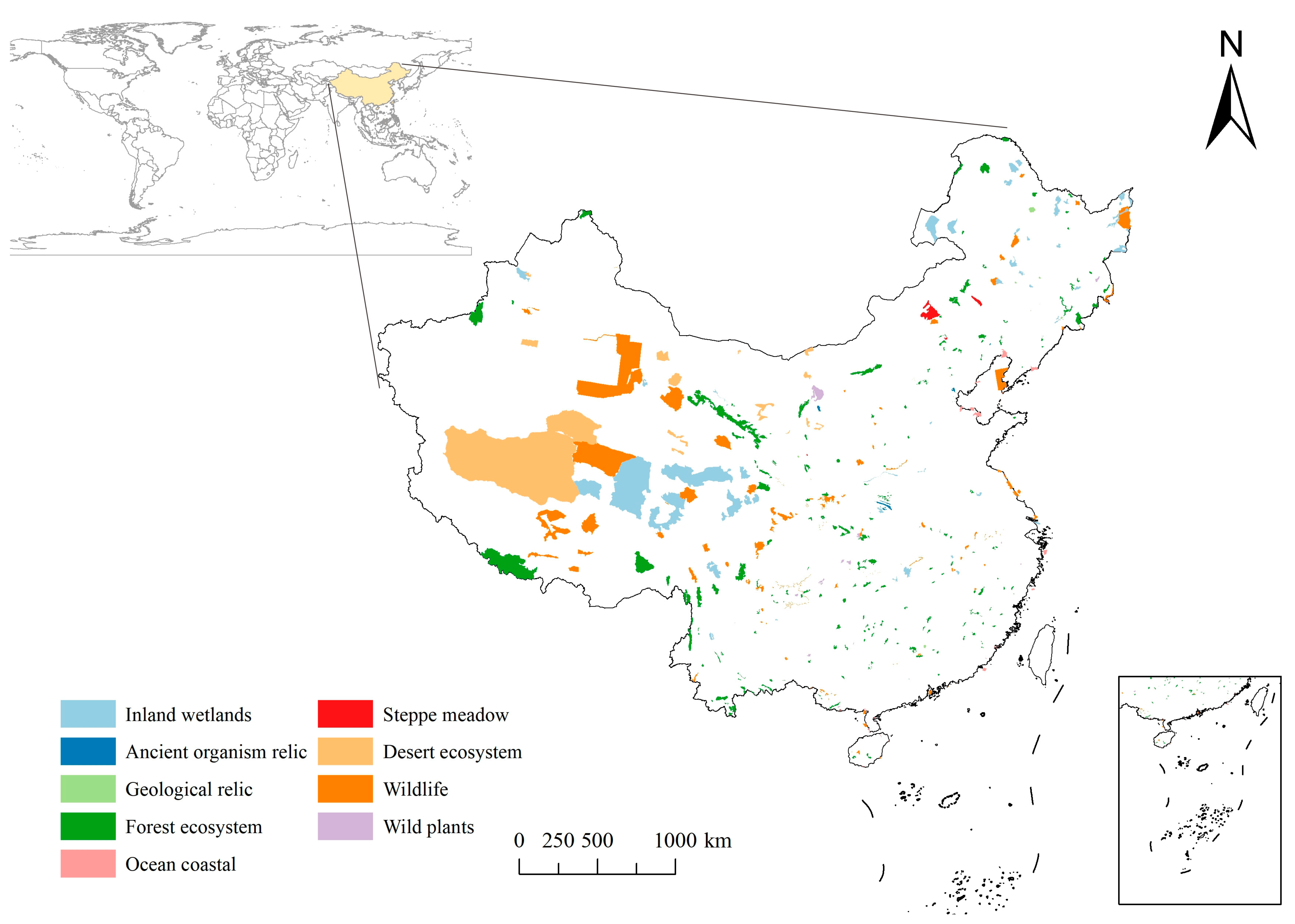
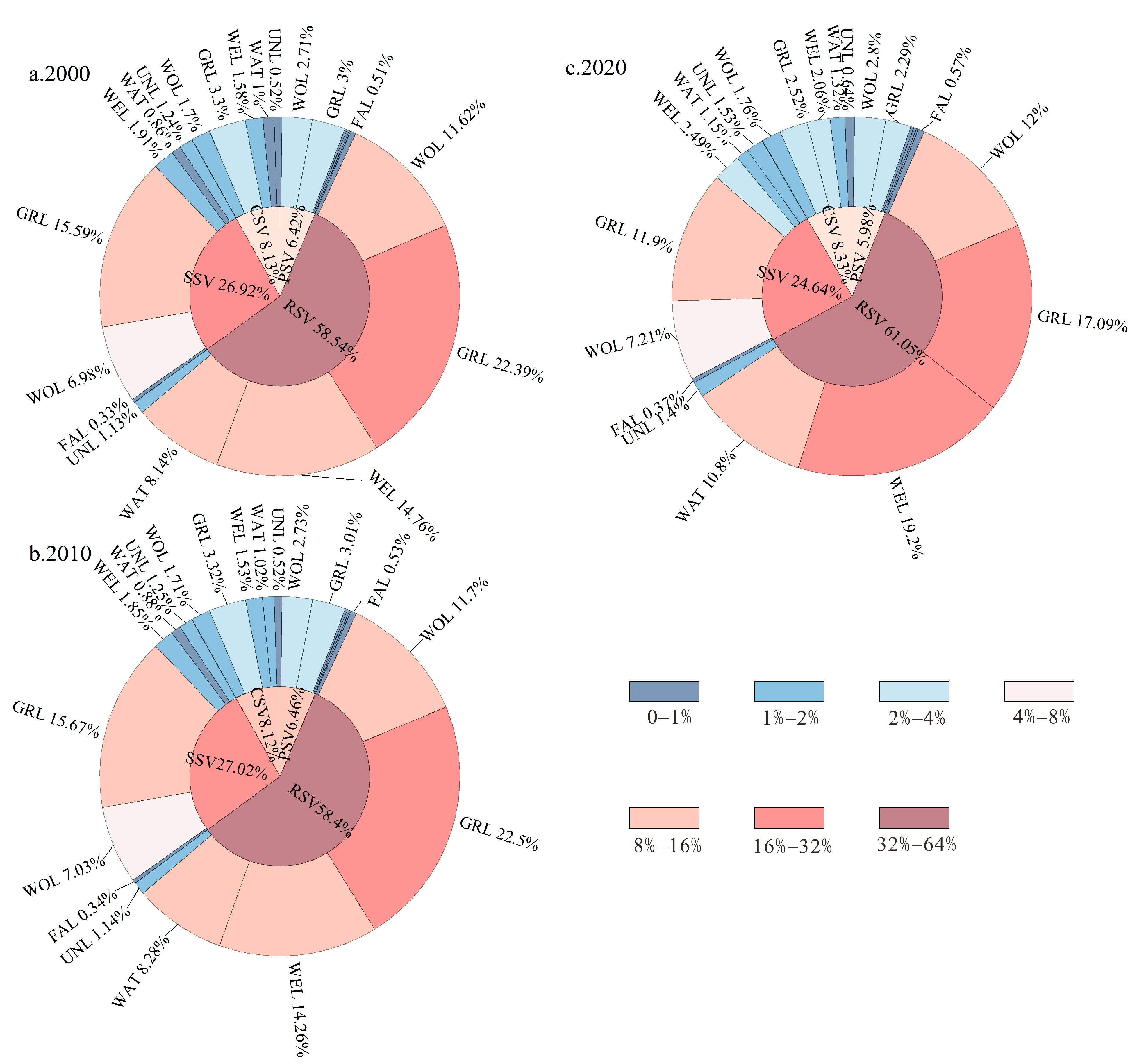

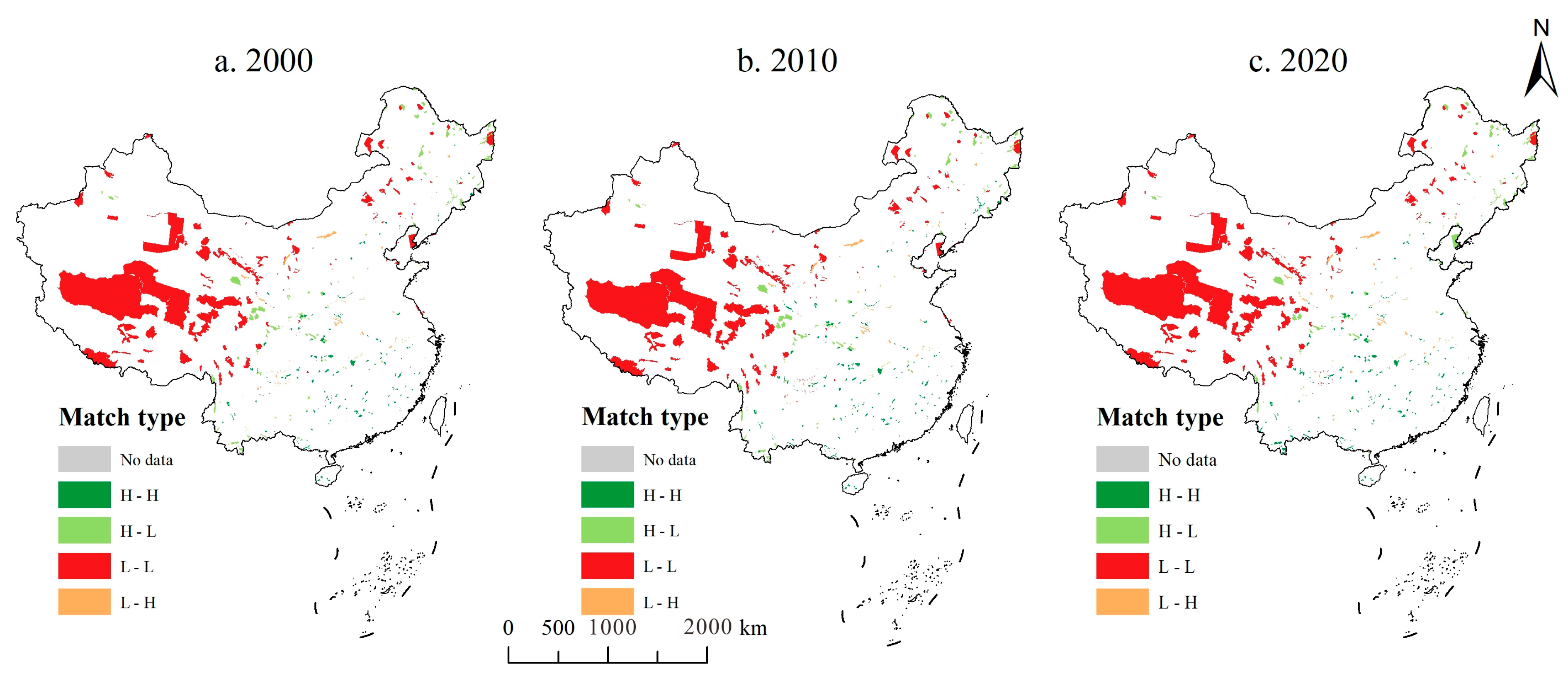
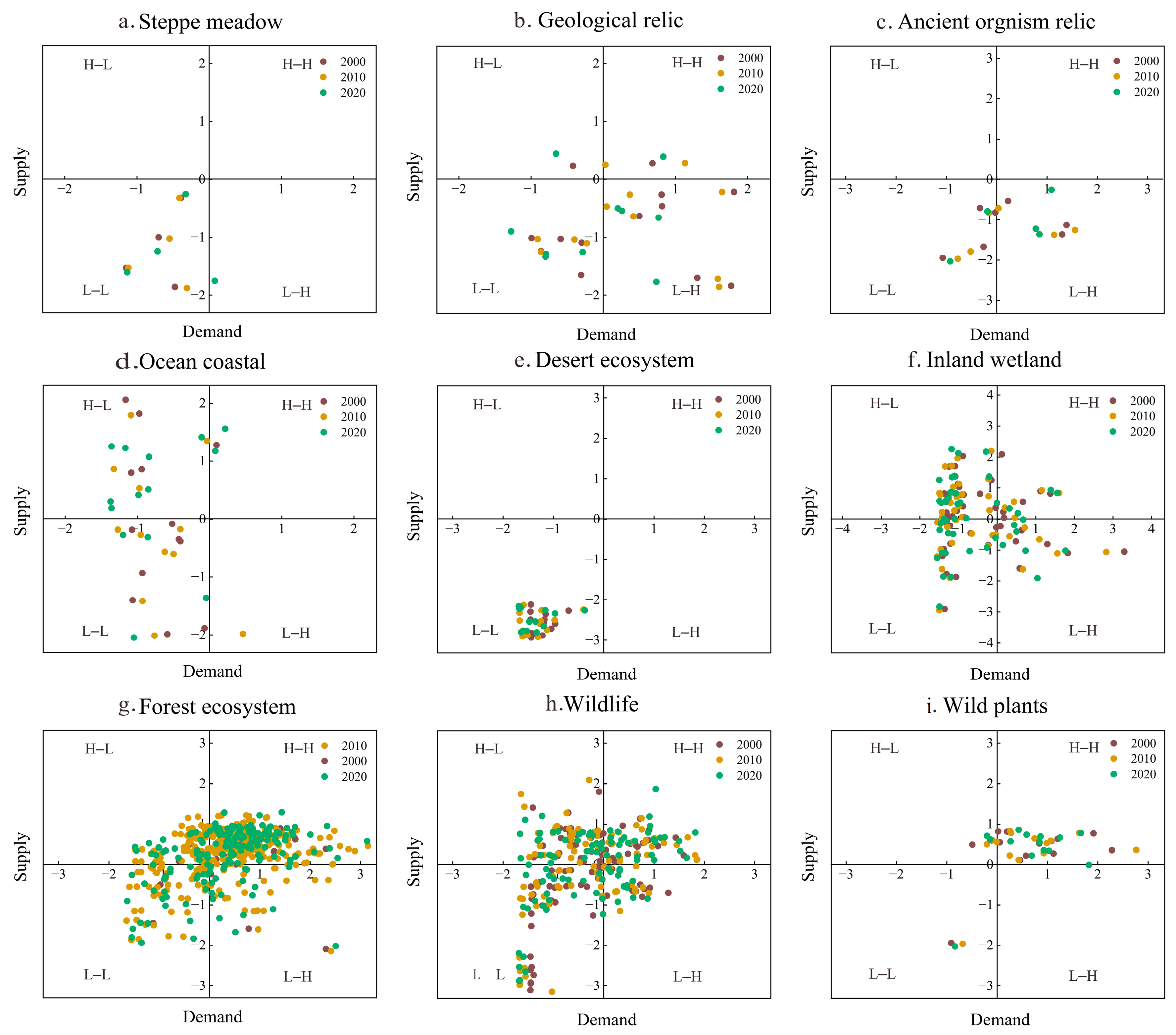

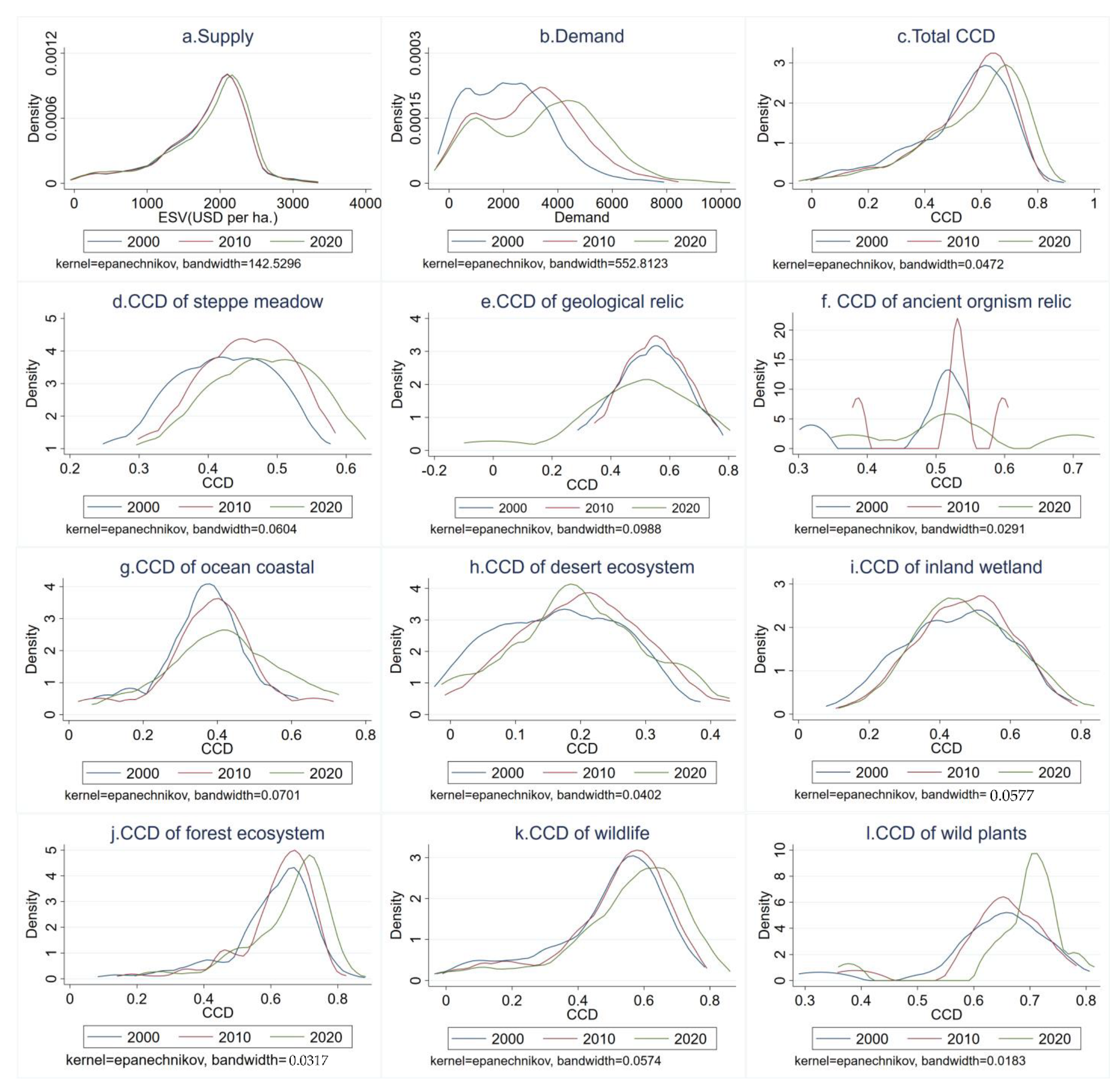
| Land Use Intensity Index (LDI) | Land Use Types | Land Use Intensity Index (LDI) | Land Use Types |
|---|---|---|---|
| LDI_1 | Unused land | LDI_3 | Farmland |
| LDI_2 | Woodland | LDI_4 | Construction land |
| Grassland | |||
| Water bodies | |||
| Wetland |
| Year | FAL | WOL | GRL | WEL | WAT | UNL | COL | Total | |
|---|---|---|---|---|---|---|---|---|---|
| PSV | 2000 | 169.74 | 2501.40 | 2769.12 | 186.81 | 182.77 | 120.39 | 0.00 | 7930.23 |
| 2010 | 174.91 | 2503.56 | 2765.21 | 179.36 | 184.74 | 120.46 | 0.00 | 7938.24 | |
| 2020 | 191.96 | 2610.22 | 2135.61 | 245.56 | 245.11 | 150.42 | 0.00 | 7598.88 | |
| RSV | 2000 | 470.14 | 10,731.08 | 20,680.79 | 13,637.07 | 7516.61 | 1043.36 | 0.00 | 56,079.05 |
| 2010 | 484.47 | 10,740.36 | 20,651.56 | 13,093.10 | 7597.48 | 1043.95 | 0.00 | 55,620.92 | |
| 2020 | 531.68 | 11,197.93 | 15,949.47 | 17,925.85 | 10,080.22 | 1303.64 | 0.00 | 59,008.79 | |
| SSV | 2000 | 304.06 | 6446.20 | 14,406.45 | 1768.46 | 797.56 | 1143.68 | 0.00 | 26,866.41 |
| 2010 | 313.33 | 6451.78 | 14,386.09 | 1697.92 | 806.14 | 1144.33 | 0.00 | 26,809.59 | |
| 2020 | 343.86 | 6726.64 | 11,110.56 | 2324.63 | 1069.58 | 1428.99 | 0.00 | 25,024.26 | |
| CSV | 2000 | 20.76 | 1571.88 | 3049.54 | 1460.23 | 922.18 | 481.55 | 0.00 | 9506.14 |
| 2010 | 21.39 | 1573.24 | 3045.23 | 1401.98 | 932.10 | 481.82 | 0.00 | 9465.76 | |
| 2020 | 23.48 | 1640.26 | 2351.87 | 1919.46 | 1236.70 | 601.68 | 0.00 | 9793.45 |
| Time Interval | Match Type | Number of Nature Reserves | |||
|---|---|---|---|---|---|
| H–H | L–H | L–L | H–L | ||
| 2000–2010 | H–H | 138 | 6 | 0 | 0 |
| L–H | 16 | 82 | 1 | 0 | |
| L–L | 1 | 0 | 99 | 10 | |
| H–L | 1 | 0 | 2 | 37 | |
| 2010–2020 | H–H | 140 | 9 | 0 | 6 |
| L–H | 12 | 70 | 5 | 2 | |
| L–L | 0 | 7 | 88 | 5 | |
| H–L | 3 | 0 | 5 | 39 | |
Disclaimer/Publisher’s Note: The statements, opinions and data contained in all publications are solely those of the individual author(s) and contributor(s) and not of MDPI and/or the editor(s). MDPI and/or the editor(s) disclaim responsibility for any injury to people or property resulting from any ideas, methods, instructions or products referred to in the content. |
© 2023 by the authors. Licensee MDPI, Basel, Switzerland. This article is an open access article distributed under the terms and conditions of the Creative Commons Attribution (CC BY) license (https://creativecommons.org/licenses/by/4.0/).
Share and Cite
Huang, C.; Zeng, J.; Chen, W.; Cui, X. Spatiotemporal Characteristics of the Coupled Coordination Degree of Ecosystem Services Supply and Demand in Chinese National Nature Reserves. Int. J. Environ. Res. Public Health 2023, 20, 4845. https://doi.org/10.3390/ijerph20064845
Huang C, Zeng J, Chen W, Cui X. Spatiotemporal Characteristics of the Coupled Coordination Degree of Ecosystem Services Supply and Demand in Chinese National Nature Reserves. International Journal of Environmental Research and Public Health. 2023; 20(6):4845. https://doi.org/10.3390/ijerph20064845
Chicago/Turabian StyleHuang, Cheng, Jie Zeng, Wanxu Chen, and Xinyu Cui. 2023. "Spatiotemporal Characteristics of the Coupled Coordination Degree of Ecosystem Services Supply and Demand in Chinese National Nature Reserves" International Journal of Environmental Research and Public Health 20, no. 6: 4845. https://doi.org/10.3390/ijerph20064845
APA StyleHuang, C., Zeng, J., Chen, W., & Cui, X. (2023). Spatiotemporal Characteristics of the Coupled Coordination Degree of Ecosystem Services Supply and Demand in Chinese National Nature Reserves. International Journal of Environmental Research and Public Health, 20(6), 4845. https://doi.org/10.3390/ijerph20064845








